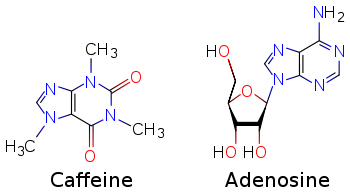Caffeine-induced rhabdomyolysis and its role in DRESS syndrome
Drug-related eosinophilia with systemic symptoms (DRESS) is a potentially life-threatening, multiorgan condition that can result from drug treatment. Antiepileptic medications are the most common cause of DRESS.
Caffeine is structurally similar to adenosine. Image source: Wikipedia, public domain.
This is case report of a 16-year-old boy with bipolar disorder who was treated with aripiprazole and fluoxetine. He developed DRESS syndrome after ingestion of high doses of caffeine.
The DRESS symptoms were classic - fever, morbilliform rash, lymphadenopathy, and visceral involvement, including leukocytosis, eosinophilia, and hepatitis.
The patient dramatically improved after corticosteroid therapy and discontinuation of all psychotropic medications.
The authors think that the development of DRESS syndrome is a net result of inconsistent medication adherence coupled with the ingestion of near-toxic doses of caffeine, which can lead to rhabdomyolysis and, through renal impairment, lead to the accumulation of toxic oxidative metabolites of the psychotropic medications.
This is one of the few reported cases of caffeine-induced rhabdomyolysis which could have lead to the development of DRESS
References:
Psychotropic Drug-Related Eosinophilia With Systemic Symptoms After Acute Caffeine Ingestion. PEDIATRICS Vol. 127 No. 1 January 2011, pp. e235-e238 (doi:10.1542/peds.2010-0374).




No comments:
Post a Comment